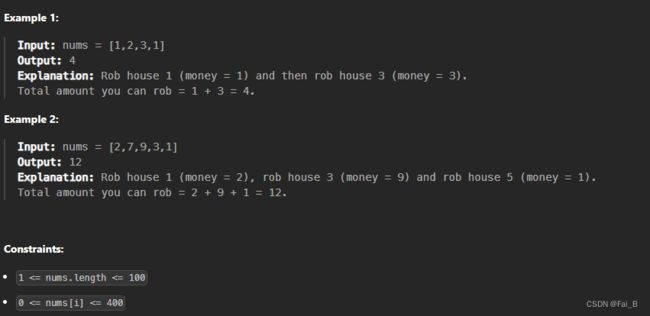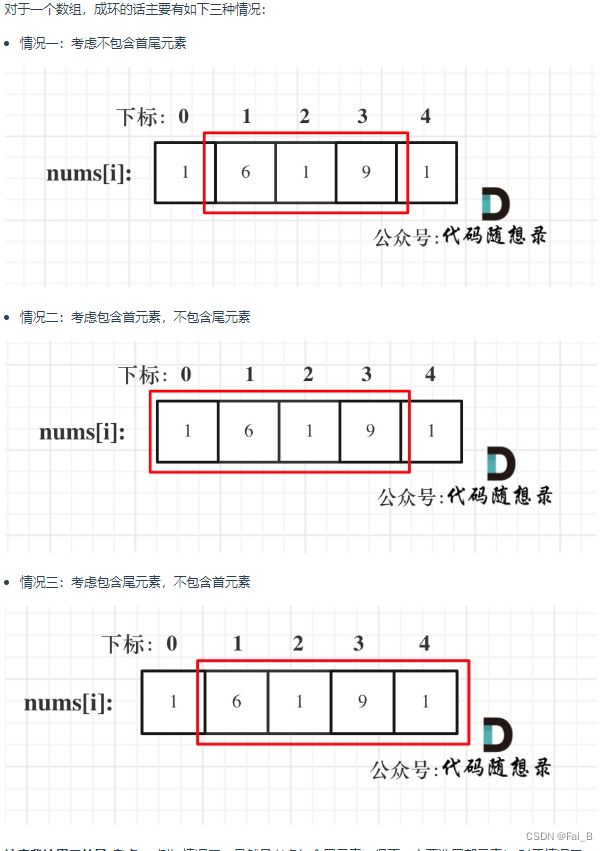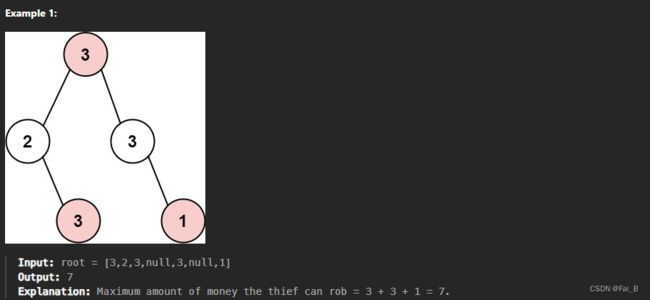198. House Robber 213. House Robber II 337. House Robber III
198. House Robber
You are a professional robber planning to rob houses along a street. Each house has a certain amount of money stashed, the only constraint stopping you from robbing each of them is that adjacent houses have security systems connected and it will automatically contact the police if two adjacent houses were broken into on the same night.
Given an integer array nums representing the amount of money of each house, return the maximum amount of money you can rob tonight without alerting the police.
1. dp[i]: the maximum amount that can be stolen from a house within subscript i is dp[i].
2. If steal room i, then dp[i] = dp[i - 2] + nums[i]
3.If we dont stolen room i, then dp[i] = dp[i - 1]
Time complexity: O(n)
Space complexity: O(n)
class Solution:
def rob(self, nums: List[int]) -> int:
if len(nums) == 1: return nums[0]
#if len(nums) == 2: return max(nums[:])
dp = [0] * (len(nums))
dp[0] = nums[0]
dp[1] = max(nums[0], nums[1])
for i in range(2, len(nums)):
dp[i] = max(dp[i - 1], dp[i - 2] + nums[i])
return dp[-1]213. House Robber II
You are a professional robber planning to rob houses along a street. Each house has a certain amount of money stashed. All houses at this place are arranged in a circle. That means the first house is the neighbor of the last one. Meanwhile, adjacent houses have a security system connected, and it will automatically contact the police if two adjacent houses were broken into on the same night.
Given an integer array nums representing the amount of money of each house, return the maximum amount of money you can rob tonight without alerting the police.
Cases II and III both cover case I, so it is sufficient to consider only cases II and III.
1-dimensional DP:
class Solution:
def rob(self, nums: List[int]) -> int:
if len(nums) < 3:
return max(nums)
result1 = self.robrange(nums[:-1])
result2 = self.robrange(nums[1:])
return max(result1, result2)
def robrange(self, nums):
dp = [0] * (len(nums))
dp[0] = nums[0]
dp[1] = max(nums[0], nums[1])
for i in range(2, len(nums)):
dp[i] = max(dp[i - 1], dp[i - 2] + nums[i])
return dp[-1]2-dimensional DP:
class Solution:
def rob(self, nums: List[int]) -> int:
if len(nums) < 3:
return max(nums)
# 情况二:不抢劫第一个房屋
result1 = self.robRange(nums[:-1])
# 情况三:不抢劫最后一个房屋
result2 = self.robRange(nums[1:])
return max(result1, result2)
def robRange(self, nums):
dp = [[0, 0] for _ in range(len(nums))]
dp[0][1] = nums[0]
for i in range(1, len(nums)):
dp[i][0] = max(dp[i - 1])
dp[i][1] = dp[i - 1][0] + nums[i]
return max(dp[-1])nomal:
class Solution:
def rob(self, nums: List[int]) -> int:
if len(nums) == 0:
return 0
if len(nums) == 1:
return nums[0]
result1 = self.robRange(nums, 0, len(nums) - 2) # 情况二
result2 = self.robRange(nums, 1, len(nums) - 1) # 情况三
return max(result1, result2)
# 198.打家劫舍的逻辑
def robRange(self, nums: List[int], start: int, end: int) -> int:
if end == start:
return nums[start]
prev_max = nums[start]
curr_max = max(nums[start], nums[start + 1])
for i in range(start + 2, end + 1):
temp = curr_max
curr_max = max(prev_max + nums[i], curr_max)
prev_max = temp
return curr_max337. House Robber III
The thief has found himself a new place for his thievery again. There is only one entrance to this area, called root.
Besides the root, each house has one and only one parent house. After a tour, the smart thief realized that all houses in this place form a binary tree. It will automatically contact the police if two directly-linked houses were broken into on the same night.
Given the root of the binary tree, return the maximum amount of money the thief can rob without alerting the police.
If we stolen the current node, the two children can't be stolen, and if the current node is not grabbed, we can consider stolen the left and right children
The function of the traversal function is: return a tuple, including the maximum value of stealing this node and the maximum value of not stealing this node
DP:
Time complexity: O(n), each node is traversed only once
Space complexity: O(log n), counting the space of recursive system stacks
# Definition for a binary tree node.
# class TreeNode:
# def __init__(self, val=0, left=None, right=None):
# self.val = val
# self.left = left
# self.right = right
class Solution:
def rob(self, root: Optional[TreeNode]) -> int:
# dp数组(dp table)以及下标的含义:
# 1. 下标为 0 记录 **不偷该节点** 所得到的的最大金钱
# 2. 下标为 1 记录 **偷该节点** 所得到的的最大金钱
dp = self.traversal(root)
return max(dp)
# 要用后序遍历, 因为要通过递归函数的返回值来做下一步计算
def traversal(self, node):
# 递归终止条件,就是遇到了空节点,那肯定是不偷的
if not node:
return (0, 0)
left = self.traversal(node.left)
right = self.traversal(node.right)
# 不偷当前节点, 偷子节点
val_0 = max(left[0], left[1]) + max(right[0], right[1])
# 偷当前节点, 不偷子节点
val_1 = node.val + left[0] + right[0]
return (val_0, val_1)violent solution: time limited
# Definition for a binary tree node.
# class TreeNode:
# def __init__(self, val=0, left=None, right=None):
# self.val = val
# self.left = left
# self.right = right
class Solution:
def rob(self, root: TreeNode) -> int:
if root is None:
return 0
if root.left is None and root.right is None:
return root.val
# 偷父节点
val1 = root.val
if root.left:
val1 += self.rob(root.left.left) + self.rob(root.left.right)
if root.right:
val1 += self.rob(root.right.left) + self.rob(root.right.right)
# 不偷父节点
val2 = self.rob(root.left) + self.rob(root.right)
return max(val1, val2)Memorized recursion:
# Definition for a binary tree node.
# class TreeNode:
# def __init__(self, val=0, left=None, right=None):
# self.val = val
# self.left = left
# self.right = right
class Solution:
memory = {}
def rob(self, root: TreeNode) -> int:
if root is None:
return 0
if root.left is None and root.right is None:
return root.val
if self.memory.get(root) is not None:
return self.memory[root]
# 偷父节点
val1 = root.val
if root.left:
val1 += self.rob(root.left.left) + self.rob(root.left.right)
if root.right:
val1 += self.rob(root.right.left) + self.rob(root.right.right)
# 不偷父节点
val2 = self.rob(root.left) + self.rob(root.right)
self.memory[root] = max(val1, val2)
return max(val1, val2)




